Oxygyrus keraudreni
Roger R. SeapyIntroduction
Along with Atlanta peroni, Oxygyrus keraudreni attains the largest size (shell diameter to 10 mm) among the Atlantidae. Body coloration is light bluish-purple, with the color darkening with age. The larval shell is calcareous and displays a distinctive pattern of zigzag-shaped spiral ridges that are evenly spaced and cover the shell surface. The teleoconch is composed of conchiolin, a transparent cartilaginous material, and its surface lacks sculpture. With growth the teleoconch overgrows the protoconch and eventually surrounds it. A shell spire, as seen in all other atlantids, is lacking and the spire region is termed involute. The conchiolin keel is glass-like and has a truncate anterior edge that ends at the shell aperture.
The type c eye morphology is only seen in one other species of atlantid (A. helicinoides) and one carinariid (Cardiapoda richardi). The shape of the operculum is unique among atlantids, broadly triangular, approaching trapezoidal in shape, and lacking the apical spiral part present in all other atlantids. Also unique to the operculum is that when the animal retracts into its shell, only about one-half of the operculum covers the shell aperture. The radula is very large and is triangular in shape. The geographical distribution is cosmopolitan in tropical to subtropical waters.
Characteristics
- Shell
- Larval shell calcareous with prominent, evenly-spaced zigzag-shaped spiral ridges covering the surface (see below)
- Adult shell and keel composed of transparent conchiolin, overgrowing the larval shell and eventually covering it except for the central portion, represented by the involute spire (see first pair of photos below)
 Click on an image to view larger version & data in a new window
Click on an image to view larger version & data in a new window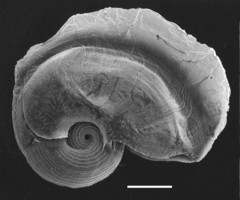
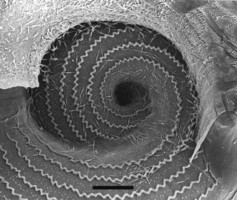
Figure. Scanning electron micrographs of the shell of a young adult (shell diameter = 2.2 mm), viewed from the right side. Left: low magnification; scale bar = 0.5 mm. Right: high magnification; scale bar = 0.1 mm. © Roger R. Seapy
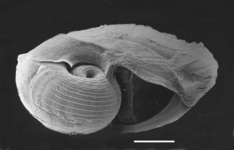
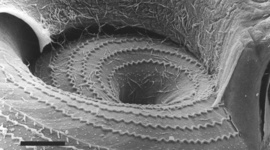
Figure. Scanning electron micrographs of the shell of the young adult Oxygyrus keraudreni shown above, viewed from ventro-lateral (apertural) side. Left: low magnification; scale bar = 0.5 mm. Right: high magnification; scale bar = 0.1 mm. Note that the critical point drying method used to prepare the specimen for examination under the scanning electron microscope resulted in a slight elevation of the base of the teleoconch from the underlying protoconchl. © Roger R. Seapy
- Larval shell calcareous with prominent, evenly-spaced zigzag-shaped spiral ridges covering the surface (see below)
- Eyes type c; distinguished by a solid black base of hemispherical shape, in which the spherical lens is situated
 Click on an image to view larger version & data in a new window
Click on an image to view larger version & data in a new window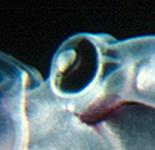
Figure. Right eye in Oxygyrus keraudreni. Photo of an enlarged portion of the title illustration. © Roger R. Seapy
- Operculum broadly triangular, approaching trapezoidal, and lacking an apical spiral portion (gyre)
 Click on an image to view larger version & data in a new window
Click on an image to view larger version & data in a new window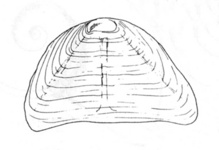
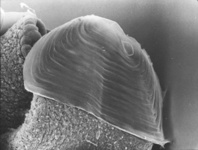
Figure. Ventral views of opercula from Oxygyrus keraudreni. Left: sketch of an intact operculum from Spoel (1976, Fig. 133), © 1976 S. van der Spoel. Right: Scanning electron micrograph of an operculum attached to the underlying opercular lobe of the foot. © Roger R. Seapy
- Radula
- Very large in comparison with other atlantids; shape elongate triangular, with a broad base
- Central tooth tricuspid, with all three cusps pointed in juveniles but lateral lobes flattened in adults
- Lateral teeth with a strong process on the inner side and a pointed accessory cusp, both of which become prominent in adults. The adjacent pair of marginal teeth are hooked and monocuspid (Richter, 1961)
- Very large in comparison with other atlantids; shape elongate triangular, with a broad base
- Larva
- Innermost tissues of larva dominated by the brown digestive gland; remaining tissues posterior to the head bluish-purple
 Click on an image to view larger version & data in a new window
Click on an image to view larger version & data in a new window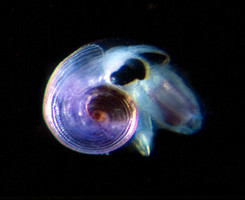
Figure. Oxygyrus keraudreni larva, viewed from the right side. © 2005 Roger R. Seapy
- Larval shell with evenly-spaced, zigzag spiral ridges on the surface
- Embryonic shell low, dome-shaped and apical in early larvae (see left sketch below). With growth the outer whorl of the larval shell progressively overrides the embryonic shell (second sketch), and eventually completely overgrows it (third sketch), resulting in the involute spire seen in late larvae and adults
- Innermost tissues of larva dominated by the brown digestive gland; remaining tissues posterior to the head bluish-purple
Comments
Oxygyrus keraudreni is a shallow-dwelling species that normally occurs in low abundances. In the Indian Ocean, Richter (1982) found that O. keraudreni was essentially limited to the upper 100 m of the water column, with 90% between 50 m and the surface. Similarly, off Hawaii Seapy (1990b) recorded low numbers of individuals whose vertical range was limited to the upper 90 m of the water column, with most individuals ocurring at night in the upper 45 m. In another study from the same area off Hawaii, Seapy (2008) found that O. keraudreni was captured in nighttime tows but was either absent or nearly so from comparable daytime ones. The results from the latter two studies suggest the possibility of daytime net avoidance.
References
Richter, G. 1961. Die Radula der Atlantiden (Heteropoda, Prosobranchia) und ihre Bedeutung f?r die Systematik und Evolution der Famiie. Morphol. ?kol. Tiere 50: 163-238.
Richter, G. 1968. Heteropoden und Heteropodenlarven im Oberfl?chenplankton des Golfs von Neapel. Pubblicazioni della Stazione Zoologica di Napoli 36: 346-400.
Richter, G. 1982. Mageninhaltsuntersuchungen an Oxygyrus keraudreni (Lesueur) (Atlantidae, Heteropoda). Beispiel einer Nahrungskette im tropischen Pelagial. Senckenbergiana Maritima 14: 47-77.
Richter, G. and R. R. Seapy. 1999. Heteropoda, pp. 621-647. In: D. Boltovskoy (ed.), South Atlantic Zooplankton. Leiden: Backhuys Publ.
Seapy, R. R. 1990a. The family Atlantidae (Gastropoda: Heteropoda) from Hawaiian waters: a faunistic survey. Malacologia 32: 107-130.
Seapy, R. R. 1990b. Patterns of vertical distribution in epipelagic heteropod molluscs off Hawaii. Marine Ecology Progress Series 60: 235-248.
Seapy, R. R. 2008. Offshore-inshore and vertical distributional patterns of heteropod mollusks off leeward Oahu, Hawaii. Marine Biology 154: 985-995.
Spoel, S. van der. 1976. Pseudothecosomata, Gymnosomata and Heteropoda (Gastropoda). Utrecht: Bohn, Scheltema & Holkema. 484 pp.
Thiriot-Quievreux, C. 1973. Heteropoda. Oceanography and Marine Biology Annual Review 11: 237-261.
Title Illustrations

| Scientific Name | Oxygyrus keraudreni |
|---|---|
| Location | Hawaiian waters |
| Specimen Condition | Live Specimen |
| Sex | Female |
| Life Cycle Stage | adult |
| View | right side |
| Image Use |
 This media file is licensed under the Creative Commons Attribution-NonCommercial License - Version 3.0. This media file is licensed under the Creative Commons Attribution-NonCommercial License - Version 3.0.
|
| Copyright |
©
Roger R. Seapy

|
About This Page
Roger R. Seapy

California State University, Fullerton, California, USA
Correspondence regarding this page should be directed to Roger R. Seapy at
rseapy@fullerton.edu
Page copyright © 2010 Roger R. Seapy
 Page: Tree of Life
Oxygyrus keraudreni .
Authored by
Roger R. Seapy.
The TEXT of this page is licensed under the
Creative Commons Attribution License - Version 3.0. Note that images and other media
featured on this page are each governed by their own license, and they may or may not be available
for reuse. Click on an image or a media link to access the media data window, which provides the
relevant licensing information. For the general terms and conditions of ToL material reuse and
redistribution, please see the Tree of Life Copyright
Policies.
Page: Tree of Life
Oxygyrus keraudreni .
Authored by
Roger R. Seapy.
The TEXT of this page is licensed under the
Creative Commons Attribution License - Version 3.0. Note that images and other media
featured on this page are each governed by their own license, and they may or may not be available
for reuse. Click on an image or a media link to access the media data window, which provides the
relevant licensing information. For the general terms and conditions of ToL material reuse and
redistribution, please see the Tree of Life Copyright
Policies.
- First online 06 October 2008
- Content changed 01 April 2010
Citing this page:
Seapy, Roger R. 2010. Oxygyrus keraudreni . Version 01 April 2010. http://tolweb.org/Oxygyrus_keraudreni/28753/2010.04.01 in The Tree of Life Web Project, http://tolweb.org/





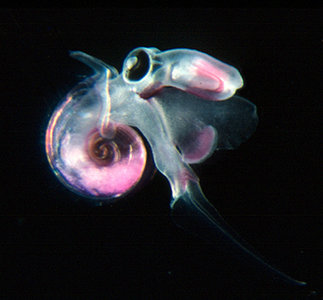
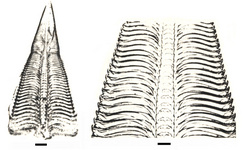
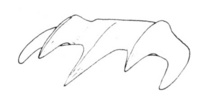

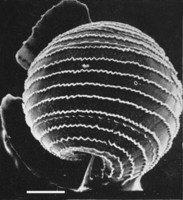
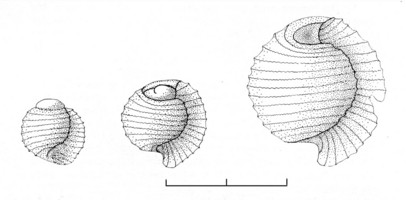



 Go to quick links
Go to quick search
Go to navigation for this section of the ToL site
Go to detailed links for the ToL site
Go to quick links
Go to quick search
Go to navigation for this section of the ToL site
Go to detailed links for the ToL site